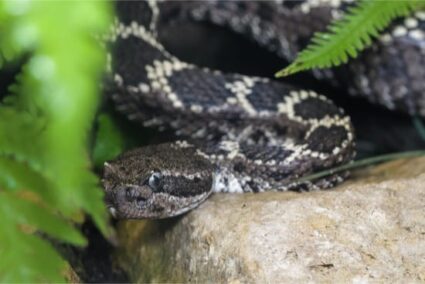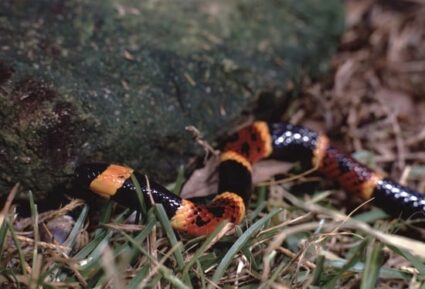To remain safe, all Arizonians need to know the different types of venomous snakes that may be encountered in their backyard or while out hiking in the wilderness. There are more than a dozen venomous species of snake in Arizona that you must learn to recognize correctly.
There are several lethal rattlesnake species found in Arizona, including Grand Canyon rattlesnakes, Arizona black rattlesnakes, Mojave rattlesnakes, and prairie rattlesnakes. You may also find Arizona coral snakes and western coral snakes. There are also many slightly-venomous, but not dangerous, colubrids.
Rattlesnakes are found from the furthest northern reaches of Arizona, all the way south to the border. This means that you can encounter deadly American snakes no matter where you go. However, the species varies depending on where you are in the valley of the sun.
How Many Venomous Snakes are in Arizona?
Arizona is home to a wide range of venomous snakes. The following rattlesnakes can be found in Arizona:
- Sidewinder Rattlesnake (Crotalus cerastes)
- Arizona Black Rattlesnake (Crotalus cerberus)
- Great Basin Rattlesnake (Crotalus oreganus lutosus)
- Grand Canyon Rattlesnake (Crotalus oreganus abyssus)
- Twin-Spotted Rattlesnake (Crotalus pricei)
- Tiger Rattlesnake (Crotalus tigris)
- Rock Rattlesnake (Crotalus lepidus)
- Banded Rock Rattlesnake (Crotalus lepidus klauberi)
- Mojave Rattlesnake (Crotalus scutulatus)
- Western Diamondback Rattlesnake (Crotalus atrox)
- Speckled Rattlesnake (Crotalus mitchelli)
- Northern Blacktail Rattlesnake (Crotalus molossus)
- Prairie Rattlesnake (Crotalus viridis)
- Hopi Rattlesnake (Crotalus viridis nuntius)
- Ridge-nosed rattlesnake (Crotalus willardi)
But these aren’t the only venomous snakes you can find. The most deadly snakes in Arizona are western coral snakes. These snakes are separated from the other coral snake species in Texas and on the east coast. Coral snake venom is just as deadly as that of a rattlesnake.
And besides rattlers and coral snakes, there are a few other species that have reasonably potent venom. They include:
- Southwestern Blackhead Snake
- Western Shovel-nosed Snake
- Lyre snake
- Night Snake
- Banded Burrowing Snake
- Brown vine snake
- Mexican vine snake
- Tropical vine snake
Naturally, some of these snakes are more venomous than others. The western diamondback rattlesnake, for example, is exceptionally dangerous.
The night snake is a rear-fanged colubrid, a group of snakes that aren’t usually venomous. However, it is slightly venomous, and uses its venom to subdue small lizards and amphibians.
Most Venomous Snakes in Arizona
Arizona’s most venomous snakes are without a doubt its many rattlesnake species. Rattlesnakes are pit vipers, a subfamily of snakes which are usually aggressive with very toxic venom.
Aside from the many rattlesnake species in Arizona, you can find two species of coral snake. These are the western coral snake and the Arizona coral snake.

Coral snakes are highly venomous, although they aren’t as aggressive as rattlesnakes. No fatalities have been reported for the Arizona coral snake despite their deadly venom.
While their venom is potent, their fangs are short and their venom glands are small, and so can’t hold much venom by volume. Rattlesnakes, by contrast, have long fangs and large venom glands.
Can Arizona Arizona Rattlesnakes Kill You?
Rattlesnakes are pit vipers, which have potent venom. They also have large venom glands. If bitten and left untreated, then it’s possible that you could die. Rattlesnake venom is both neurotoxic and hemotoxic.
Neurotoxins destroy nerve tissue, meaning that your body can’t function properly, while hemotoxins cause necrosis (tissue death) and disrupted blood clotting. The effects of rattlesnake venom include:
- Difficulty breathing. You start by finding it difficult to draw deep breaths. If the impact is severe, you find it difficult to breathe at all. That’s because the nervous system is damaged, so your brain can’t tell your lungs to keep breathing.
- Tissue death. The tissue around the bite mark will start to turn black and die. You may need to get your limb amputated to prevent the necrosis from spreading.
- Nausea. You may feel a strong urge to vomit.
- Dizziness and trouble balancing. The venom is affecting your nervous system. Your brain is struggling to tell your body what to do because your nerve endings are coated with venom.
Can Coral Snakes Kill You?
Arizona’s coral snakes have the potent neurotoxic venom of all U.S. snakes. However, their fangs and venom glands are small. This, coupled with their shy temperament, means that you’re less likely to get bitten.
Rather than relying on their venom to defend themselves, coral snakes will try to avoid people. If they see you approaching them, they’ll burrow to try and get away from you. Snakes like these are called ‘fossorial’ snakes.
Snakes developed venom to hunt prey. Coral snakes, being quite small, only eat tiny frogs and lizards. They have enough venom to kill their prey. They’ll only defend themselves from humans if they feel cornered. Bites are very infrequent, and can be avoided if you take proper precautions.

Can Venomous Colubrids Kill You?
Colubrids aren’t known for their venom. Take the brown vine snake, for example. This is a species that has rear-facing fangs.
According to the Journal of Toxicology, colubrids don’t have venom glands like elapids (e.g., coral snakes) and pit vipers (e.g., rattlesnakes). Instead, they have a gland called Duvernoy’s gland. They produce venom, but lack a large reservoir, so they have hardly any.
Their bite isn’t fatal for humans. When they hunt and bite their prey, their venom has an incapacitative effect. If they were to bite you, though, all that you would experience is a stinging and itching sensation.
When Do Snakes Come Out in Arizona?
In cooler climates, snakes come out in the spring, stay out during the summer, and head back to their hiding places during fall before the lowest temperatures hit. They then brumate, which is like hibernation. But, in Arizona, snakes don’t follow that same pattern.
Snakes are active throughout the summer. But they’ll frequently have to find hiding places to get out of the summer sun. They’ll wait until the Fall, especially September, when the temperatures are a little cooler. They’re also more active in the Spring, which is mating season. As for the time of day when snakes come out, it varies by species.
- Some snakes are nocturnal, and only come out at night, when it’s cool. Rattlesnakes aren’t typically nocturnal, and their vision works best in the daylight. However, they can hunt at night using their heat pits.
- Snakes that usually come out during the day are diurnal. Coral snakes are an example of a diurnal snake.
- There are ‘crepuscular’ snakes. These snakes are most active during either dawn or dusk, when it’s light enough to see, but not too hot to move around comfortably. Whip snakes are crepuscular snakes.
You can encounter snakes no matter what the time of day. But, in the daytime, you should look out for coral snakes. At dawn and dusk, you should stay alert for rattlesnakes. But, if you’re hiking, you should be on the lookout for snakes constantly.
How to Avoid Snakes in Arizona
If you want to hike a trail in Arizona, you won’t be able to find anywhere that’s guaranteed to be snake-free. Learn how to avoid snakes, and find out what you should do if you encounter one:
Snake-proof chaps and leggings provide protection against snakes biting your ankles and feet. Snake-proof boots do much the same. Considering that most snake bites are to the lower legs or ankles.
If there’s a snake on the trail ahead, there are ways to make your situation less dangerous. Find another path. Turn back and try a different way. Avoid approaching the snake, especially if it’s acting defensive.
Stick to the middle of the path. If there’s lots of long grass and undergrowth along the sides of the path, then there may be snakes hiding there. Hike well-maintained trails where there are fewer hiding places for snakes, plus any dangerous (poisonous) snakes will be dealt with by park rangers.
If you do take another path, or give the snake a wide berth, bear in mind that rattlesnakes live in clusters. They aren’t social animals, but they share ‘hibernacula,’ i.e. hiding places. If you see one snake, you can guarantee that there will be more Arizona rattlesnakes nearby.

